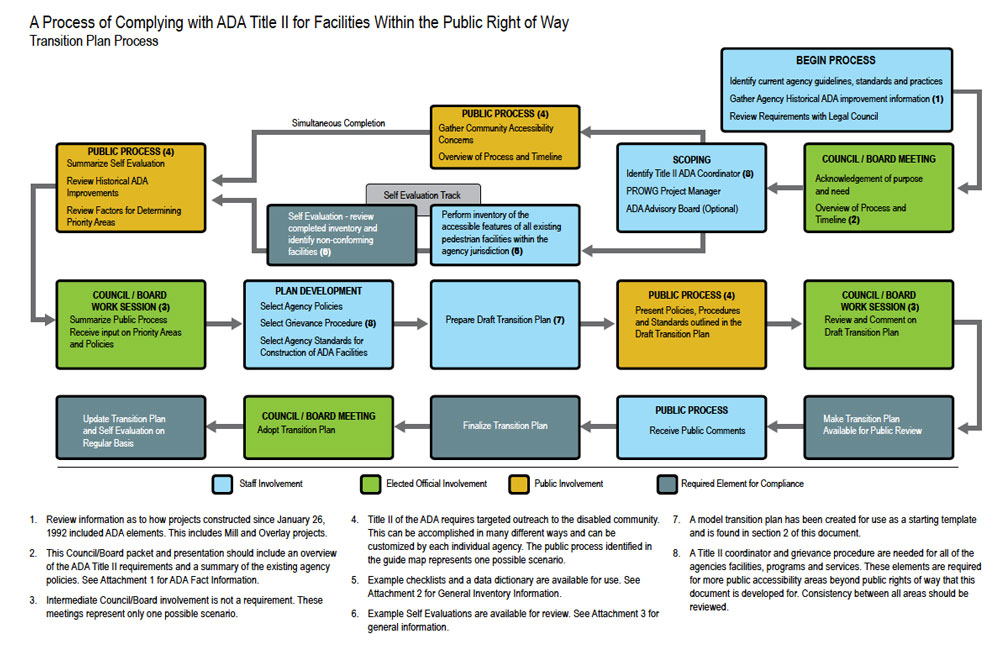Introduction
This guide outlines the process for Minnesota public agencies to develop an Americans with Disabilities Act (ADA) Transition Plan for public rights of way. It supplements a toolkit developed by the Department of Justice to help local governments comply with Title II Public Rights of Way aspect of the American’s with Disabilities Act (ADA) Requirements set forth in the Code of Federal Regulations (C.F.R.).
Each agency has been required to evaluate its services, policies and practices and the effects thereof that do not meet the requirements set forth in the ADA. For any structural changes to facilities outlined in that evaluation that are needed to achieve program accessibility, a transition plan is required to be developed. While this guidebook only relates to an agency’s public rights of way, many sections of the document need to be closely coordinated with any other transition plans the agency may have to provide seamless procedures and service.
Important: Obtain legal counsel regarding the advisability of using information in this document or in its attachments.
About this Guide
Authors: Michael Marti, James Gersema and Renae Kuehl, SRF Consulting Group
Date: June 2012 (originally produced as an interactive PDF guide – 2012RIC01)
Sponsoring Organization: Local Road Research Board
Contact: MnDOT Research Services – research.dot@state.mn.us or 651-366-3780.
Document Analysis/Descriptors:
Americans with Disabilities Act, ADA, ADA Title II, Section 504, PROWAG, Uniform Accessibility Standards, Transition Plan, ADA Compliance, ADA Design Standards, Accessibility, APS, Sidewalks, Curb Ramps, Self-Evaluation, ADA Coordinator, Infrastructure Inventory, Physical Barriers, Grievance Procedures, Public Rights of Ways
Dept. of Justice Guidance
In 2006 and 2007, the Civil Rights Division of the U.S. Department of Justice (DOJ) developed a toolkit, which includes four installments of a new technical assistance document designed to assist state and local officials to improve compliance with Title II of the Americans with Disabilities Act (ADA) in their programs, services, activities, and facilities. This document is entitled The ADA Best Practices Tool Kit for State and Local Governments and can be found on the internet at: https://www.ada.gov/pcatoolkit/toolkitmain.htm
LRRB Guide
This online guide offers step-by-step guidance for Minnesota local agencies to develop an Americans with Disabilities Act (ADA) Transition Plan for public rights of way.
A variety of resources are found in two sections:
Section 1 – A process for complying with ADA Title II for Public Rights of Way
Section 2 – Model Transition Plan (includes template)
Section 1
Section 1: Process Flow Chart

A Process of Complying with ADA Title II for Facilities Within the Public Right of Way Transition Plan Process
Attachment 1 – ADA Fact Sheets for Elected Officials
- The ADA and City Governments: Common Problems
- FHWA Frequently Asked Questions
Attachment 2 – Example Checklists and Data Dictionary for Inventory Process
- Department of Justice Example Checklists
- MnDOT Curb Ramp Inventory Data Fields
- MnDOT Sidewalk Inventory Data Fields
- Scott County ADA Inventory Template
For Construction Purposes
Attachment 3 – Example Self-Evaluations
High Level Self-Evaluations:
Detailed Self-Evaluations Examples:
Section 2
Section 2: Model Transition Plan
The following two pages include the outline for the Model Transition Plan Template that has been develop for local agencies to use in developing their own plans. The buttons to the right include:
Model Transition Plan Template – This document is intended for local agencies to use as a base in developing their own transition plan. It is provided as a Word document so you can edit the text to best for your agency. The highlighted text within the document is intended for you to update with your county specific data.
Transition Plan Commentary – This document provides commentary for each of the sections in the Model Transition Plan Template listed above. It is intended to be referenced when using the template, so that the user understands what information is necessary for each section and why.
- Introduction
- Self-Evaluation – Physical barriers in the agencies infrastructure that limits accessibility
- Policies and practices – Detailed description of the methods to remove these barriers and make the facilities accessible. Identification of the standards to be followed.
- Improvements priorities – Long-term priorities/timeline to complete the improvements
- ADA Coordinator (Title II) – Person within the agency who will be responsible for the implementation of the identified improvements
- Implementation schedule – Summary of the schedule and budget for specific improvements
- Public outreach – Summary of public outreach program and input received
- Grievance procedure – Summary of the agencies process to resolve complaints of disability discrimination
- Monitor the progress – record of scheduled updates to the plan
Appendices to the model transition plan:
- Self-Evaluation Results – A detailed list of physical barriers in the agencies infrastructure that limits accessibility
- Schedule/Budget – Detailed schedule and budget for specific improvements
- Public Outreach – Detailed record of public outreach program and input received
- Grievance procedure – Detailed official process to resolve complaints of disability discrimination
- Contact Information
- Agency ADA Design Standards and Procedures
- Glossary of Terms
Resources
Additional resources are available:
- U.S. Department of Justice – ADA Information and Technical Assistance. https://www.ada.gov/
- MnDOT – Information on what MnDOT is doing to make transportation accessible to everyone.
https://www.dot.state.mn.us/ada/ - Federal Highway Administration – Accessibility Resource Library. https://www.fhwa.dot.gov/accessibility/
- Great Lakes ADA Center – Resource to increase awareness and knowledge of ADA compliance.
https://www.adagreatlakes.org/ - United States Access Board – A Federal Agency Committed to Accessible Design.
https://www.access-board.gov/ - Accessible Pedestrian Signals – A Guide to Best Practices.
https://www.apsguide.org/index.cfm - Accessibility Online – free webinars and audio conferences on accessibility topics.
https://www.accessibilityonline.org/